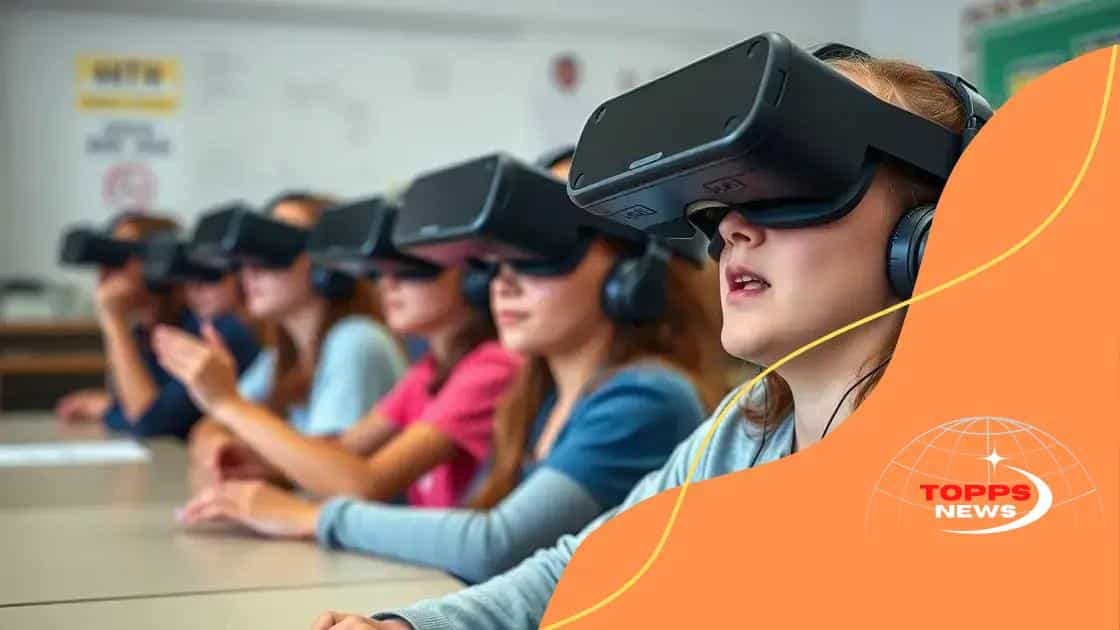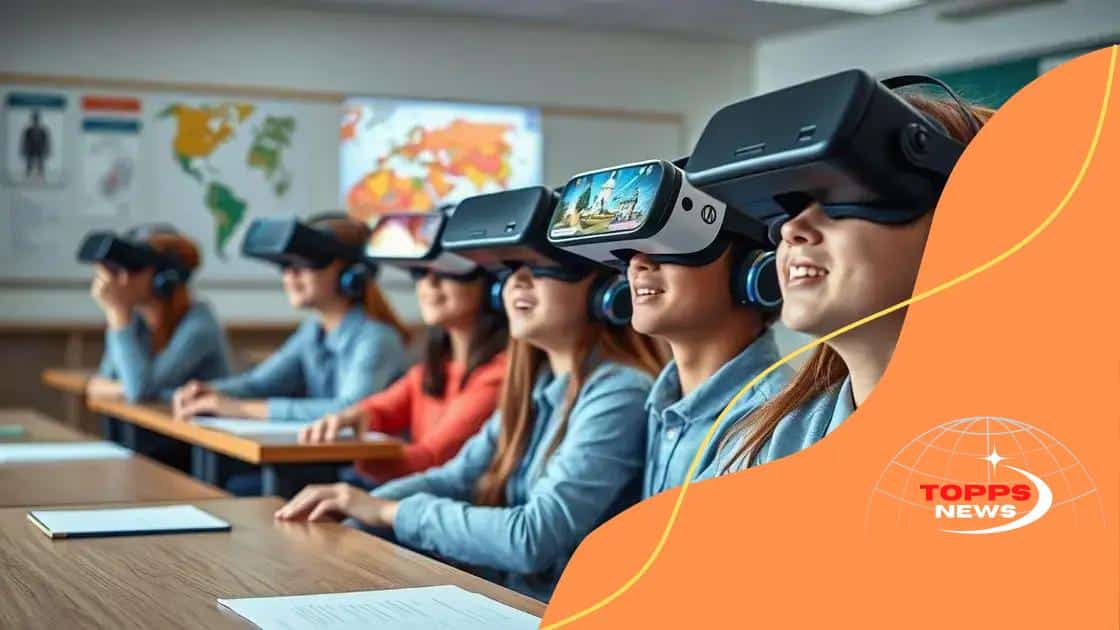Virtual reality in STEM education: engaging students

Virtual reality in STEM education enhances student engagement and understanding by providing immersive, interactive experiences that make complex concepts easier to grasp and promote collaboration among learners.
Virtual reality in STEM education has the potential to transform how students learn about complex scientific concepts. Imagine being able to explore the universe or dissect a virtual cell without ever leaving the classroom. This technology not only captivates students but also fosters deeper understanding. Let’s dive into how VR is shaping education.
Understanding virtual reality technology
Understanding virtual reality technology involves grasping how this innovative tool works and its applications in education. Virtual reality (VR) creates simulated environments that allow users to engage and interact with digital content in a three-dimensional space. This technology is rapidly being integrated into STEM education, bridging the gap between complex theories and practical understanding.
VR technology uses headsets equipped with motion sensors, which track a user’s movements and adjust the display accordingly. This immersive experience helps students visualize concepts that might be difficult to grasp through traditional methods. For instance, imagine exploring the human anatomy or a geographical landscape fully immersed in a virtual world.
Key Components of VR Technology
There are several key components that drive VR technology:
- Headsets: These devices block out the real world and create a fully immersive environment.
- Motion Tracking: This allows the system to understand where the user is looking and moving.
- Interactive Controls: Objects within the virtual environment can be manipulated using specialized controllers.
- 3D Audio: Sound enhances the realism, helping to immerse the user even further.
As the technology evolves, educators can create tailored experiences that cater to diverse learning styles. Imagine a student exploring the depths of the ocean without leaving the classroom or visiting historical landmarks in a VR setting. This hands-on approach fosters increased engagement and retention of information.
Through the use of VR, students can experiment, make mistakes, and learn in a safe environment. This technology also allows for collaboration among peers in a virtual space, promoting teamwork and problem-solving skills. For example, a group of students can work together to construct a virtual bridge, enhancing their understanding of engineering principles.
As more educational institutions adopt VR, we can see a shift in how students perceive learning. By incorporating these elements, VR is not just a technological advancement; it’s a new way of teaching and learning that engages students deeply. With its capacity to make learning interactive and visually appealing, VR is paving the way for a bright future in STEM education.
The benefits of VR in STEM education
The benefits of VR in STEM education are numerous and impactful. This technology offers unique opportunities for students to engage with complex subjects in an interactive manner. By immersing themselves in virtual environments, learners can grasp challenging concepts more effectively than through traditional teaching methods.
One significant advantage of VR is its ability to create realistic simulations. Students can conduct virtual experiments in a controlled setting, which enhances their understanding of scientific principles. For instance, they can explore chemical reactions or physical laws without any safety risks. This hands-on experience is crucial in reinforcing theoretical knowledge.
Enhanced Learning Experiences
The immersive nature of VR provides enhanced learning experiences that are both engaging and memorable. Through visualization, students can:
- Interact: Engage directly with concepts that would otherwise be abstract.
- Visualize: See 3D models of structures, such as DNA or machinery, facilitating a deeper understanding.
- Experiment: Conduct experiments that would be impossible in a traditional classroom setting.
- Cohesion: Foster teamwork as students collaborate within virtual scenarios.
Furthermore, VR allows for personalized learning experiences. Students can progress at their own pace, revisiting challenging concepts as needed. This flexibility caters to diverse learning styles and helps to build confidence among students who may struggle with standard curricula.
In addition, using VR in the classroom can foster creativity and problem-solving skills. For example, students might engage in challenges that require them to design solutions to complex problems. Such activities not only promote critical thinking but also prepare them for future real-world applications.
Integrating VR technology into STEM education opens doors to remote learning opportunities. Students can explore locations and concepts that are not feasible in their local environments, broadening their educational horizons. This accessibility is particularly advantageous for students in underserved areas.
Overall, the application of VR in STEM education brings rich, experiential learning that transforms how students understand and interact with the world around them. From fostering critical skills to expanding learning opportunities, the benefits are undeniable.
Successful VR implementations in classrooms

Successful VR implementations in classrooms showcase how this technology can transform learning environments. Many educators have begun to integrate virtual reality into their lessons, resulting in innovative teaching practices that engage students and enhance comprehension.
For instance, schools around the world are using VR to take students on virtual field trips. These experiences allow learners to visit historical sites, natural wonders, or even outer space without leaving their classroom. Such trips enrich the curriculum and create memorable learning experiences that textbooks cannot offer.
Case Studies of VR in Education
Numerous case studies highlight the positive impacts of VR in education. Here are some notable examples:
- Google Expeditions: This program allows students to explore different environments and cultures through VR. Teachers can take their classes on guided tours of everything from the ocean’s depths to ancient ruins.
- Labster: With this platform, students can conduct science experiments in a virtual lab. This approach not only saves resources but also makes it safe to explore complex scientific concepts.
- Immerse: This platform offers customized VR experiences that focus on English language learning. Students engage in realistic conversations that help improve their language skills.
- Virtual Reality in Medicine: Medical schools are using VR to allow future doctors to practice surgical techniques in a simulated environment. This hands-on training prepares them for real-life medical situations.
Beyond these case studies, the feedback from students and teachers has been overwhelmingly positive. Learners express their excitement and interest in participating in VR activities. This enthusiasm often leads to an increase in motivation and a willingness to learn.
Additionally, teachers report that VR helps to capture students’ attention more effectively than traditional methods. The interactive nature of the technology encourages active participation, making lessons more dynamic. Students are not just passive recipients of information but active participants in their own learning.
The successful integration of VR into classrooms also fosters collaboration among students. Group projects conducted in virtual reality create opportunities for teamwork and communication. These skills are vital for students as they prepare for future careers.
Challenges of using VR in education
Challenges of using VR in education can impact the effectiveness of this innovative technology. While virtual reality has many benefits, there are still obstacles that educators face when implementing it in classrooms.
One major challenge is the cost associated with VR technology. Purchasing headsets, software, and additional equipment can be expensive, making it difficult for some schools to adopt. Many educational institutions may lack the budget needed to provide sufficient resources to all students.
Technical Barriers
Another significant issue is the technical complexity involved with VR systems. Setting up the equipment and ensuring it works properly can be time-consuming and may require specialized training for teachers. Furthermore, technical difficulties during lessons can disrupt the learning process, which might discourage educators from using the technology.
The user experience also matters. Students with different levels of tech-savviness might struggle to adapt to VR environments. Some may find it overwhelming, while others might not engage with the content as intended. Educators need to ensure that all students can benefit from VR experiences.
Content Availability and Curriculum Integration
Integrating VR into existing curricula poses another challenge. There is often a limited amount of high-quality educational VR content available that matches learning objectives. Teachers must spend extra time finding suitable resources or creating their own content to make VR effective in the classroom.
This also highlights the need for ongoing training. Providing teachers with adequate professional development is crucial for embracing VR effectively. Without proper training, educators may feel unsure about how to incorporate VR into their lessons, limiting its potential benefits.
Lastly, there are concerns about accessibility. Not all students can use VR due to physical limitations, such as motion sickness or visual impairments. Additionally, schools in underserved areas may struggle to provide access to this technology for all students, risking an educational divide.
Future outlook for VR in STEM learning
Future outlook for VR in STEM learning appears promising as technology continues to advance. Educators and institutions are increasingly recognizing the potential of virtual reality to enhance student engagement and understanding. With ongoing innovations, we can expect more widespread adoption of VR in various educational settings.
As VR technology becomes more affordable, schools across different regions will likely invest in it. This increased accessibility will allow many students to experience interactive learning environments. For example, students might soon explore historical events or complex scientific theories in immersive ways, making education more relatable.
Expanding Content Library
The development of a broader library of educational VR resources is crucial. As more content creators enter the educational space, we can anticipate a wealth of high-quality VR experiences tailored to different subjects. This variety will give educators the tools they need to effectively integrate VR into their curricula.
Additionally, partnerships between tech companies and educational institutions are expected to grow. These collaborations will help ensure that VR content aligns with curriculum standards and learning objectives, enabling teachers to maximize its benefits.
Interactive Learning Environments
Future classrooms may incorporate more advanced VR systems that allow for collaborative experiences. Students could work together in virtual environments, solving problems or completing projects in real-time, regardless of their physical location. This shift will foster teamwork and communication skills, essential for future careers.
Furthermore, advancements in VR will enhance user experiences. Improved graphics, higher resolution, and more realistic simulations will create more immersive learning environments. These developments will help to engage students’ senses, leading to better retention of information.
Alongside this, educators will likely receive ongoing training to help them effectively utilize VR in their teaching. Professional development will equip teachers with the necessary skills to create engaging lessons and foster student participation. This support will be essential as VR becomes a mainstay in STEM education.
Lastly, the impact of VR on remote and hybrid learning scenarios will likely continue to grow. As more educational institutions adopt flexible learning models, VR can provide innovative solutions for delivering engaging content to students regardless of their location.
FAQ – Frequently Asked Questions about Virtual Reality in STEM Education
What are the main benefits of using VR in education?
VR enhances engagement, provides immersive learning experiences, and helps students understand complex concepts more easily.
How can schools afford VR technology?
As VR technology becomes more affordable and accessible, schools can invest in it through grants, partnerships, and funding specifically for educational resources.
What challenges do educators face when implementing VR?
Challenges include high costs, technical issues, limited content availability, and the need for ongoing teacher training.
How will VR shape the future of learning?
The future of learning with VR will involve more personalized experiences, increased collaboration among students, and a broader range of educational content.





